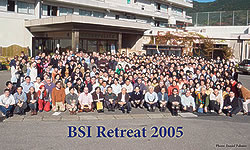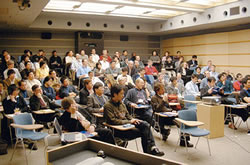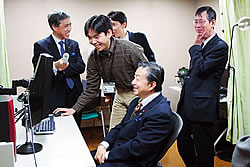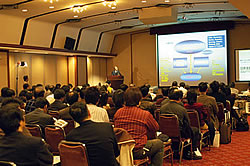Eighth BSI Retreat
From 31 October to 2 November 2005, the eighth BSI Retreat took place at Kinugawa Green Palace in Tochigi Prefecture.
The Retreat provides BSI researchers with the opportunity for open discussion and constructive interactions between researchers from other laboratories in a informal atmosphere. 350 researchers participated this year, including some from RIKEN-MIT Neuroscience Research Center. There were about 270 poster presentations. Question-and-answer sessions and discussions throughout the Retreat are likely to encourage more interactive research across the different laboratories.
Lectures by Mark Bear at MIT Picower Institute and John Rubenstein from University of California, San Francisco were warmly received by the audience. RIKEN BSI and UCSF foster research cooperation through such annual exchanges.
RIKEN BSI seeks to fully exploit its talent by ensuring that successful, comprehensive brain research produces meaningful results. The Retreat contributes to this by deepening interactions between researchers working across different fields.
Japan-Germany Symposium on Computational Neuroscience
The past year (from April to March) was "A year of Germany in Japan 2005-06". As a part of the related events, RIKEN organized the "Japan-Germany Symposium on Computational Neuroscience" on campus from 2-4 February 2006.
The symposium was attended by researchers from Japanese and German research institutions as well as by five speakers invited from other countries. Thirty German nationals joined the meeting that included twenty-six oral presentations and fifty-three poster presentations on various aspects of computational neuroscience. The energy displayed in the discussion attests to the success of the symposium.
Topics of the invited lecture sessions included temporal modeling of song learning in birds (Dr. S. Seung, MIT) and neural spiking, as well as modeling the expression of neural information expression (Dr. A. Destxehe, CNRS). Dr. Brunel, also of CNRS, introduced an ingenious theoretical analysis of circuit dynamics of neuronal spikes and Dr. Wang from Brandeis University attempted to explain perception in visual cognition with a biologically based model of neural circuit model. Finally, Dr. Schwartz from the University of Pittsburgh showed how a Brain Machine Interface device could use neural activity in a monkey's motor cortex to control a robotic arm. In fact, in three days, most of those issues facing computational neuroscientists were addressed.
Many of the symposium's participants gave the even high praise. Organizing similar sessions to enable Japanese and German scientists to gather and exchange ideas related to computational neuroscience would further deepen research cooperation between the nations.
Minister Kenji Kosaka of MEXT Visits BSI
As part of a RIKEN Inspection, Minister Kenji Kosaka from MEXT visited BSI on 27 February 2006. Dr. Ryota Horie of the laboratory for Language Development, who explained to the Kosaka how vocal cognition experiments pair voice stimuli and eye movement to determine how reading capability develops in infants. Kosaka himself became a test subject and asked questions revealing his keen interest the work.
A presentation on the brain science followed that covered emotional and social development of children by Unit Leader, Dr. Tadaharu Tsumoto and Group Director, Dr. Tadafumi Kato. The minister suggested that making closer ties with child educators and expressed hopes that the research develop positively.
The relaxed mood throughout the inspection strengthened Kosaka's interest and clarified his expectations for brain science research in the future.
Forum to kick-off Japan's contribution to Neuroinformatics
As an information system, a neuroinformatics platform will enable efficient dissemination and integration of relevant brain science data that will foster a systematic understanding of the brain. Developing such a platform effectively should integrate new advances in information technology. To this end, an International Neuroinformatics Coordinating Facility (INCF) was established in July 2005 to coordinate international efforts. Three months earlier, BSI was granted authority to establish a domestic centre, the Neuroinformatics Japan Center (NIJC). Locating the Japan Node of INCF at BSI seemed a logical extension of these activities.
To inaugurate these activities BSI hosted a one-day forum on 27 February 2006 in Tokyo: "Neuroinformatics: Development of Brain Science in the IT Age". Drs. Mitsuo Kawato (of ATR in Nara), Kazuyuki Aihara (Univ. of Tokyo) and Shiro Usui (BSI) lectures, and panel discussions followed that included Drs. Yoichi Tohkura (NII) and Kenji Doya (OIST, Okinawa Institute of Science and Technology). More than 220 participants engaged in discussions that went beyond the allotted time. A general outline of the forum is available at: http://www.neuroinf.jp/modules/xoonips/detail.php?item_id=224









